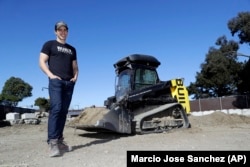When Noah Ready-Campbell was a young adult, he worked for his father’s construction company.
Back then, he dreamed of a day when robots might take over the dirty, repetitive parts of his job, such as earthmoving and leveling.
Years later, Ready-Campbell left his job as an engineer with Google to make that dream come true.
Ready-Campbell formed a start-up called Built Robotics. The San Francisco, California-based company develops technology to produce self-driving heavy equipment. Ready-Campbell says the company’s goal is to make construction safer, faster and less costly.
The construction industry has fallen behind others when it comes to the use of new technologies such as robotics. Built Robotics is part of a new wave of automation.
Investors are putting more and more money into start-ups that are developing robots, software and other technology for construction.
The industry struggles to find skilled workers and faces a growing number of unfinished projects. But self-operating machines are changing the nature of building.
Michael Chui is with the McKinsey Global Institute, a business research organization in San Francisco. Chui told the AP, “We need all of the robots we can get, plus all of the workers working, in order to have economic growth.”
He added, “As machines do some of the work that people used to do, the people have to … transition to other forms of work, which means lots of retraining.”
Workers at Berich Masonry in Englewood, Colorado, recently spent several weeks learning how to operate a robot called SAM, or the Semi-Automated Mason. SAM is a $400,000 machine from the company Construction Robotics, based in Victor, New York.
The machine can lay 3,000 bricks in eight-hours, a normal workday. That is several times more than a human bricklayer can do in the same period. But humans are still needed to load bricks into the SAM and make sure it works right.
Todd Berich is president of Berich Masonry. He wants the improved technology to permit the company to accept new projects.
“Right now I have to tell them ‘no’ because we’re at capacity,” he said.
Bricklayer Michael Walsh says the SAM lessens the load on his body. But he does not think it will take his job.
Brian Kennedy agrees. He is the policy director for the International Union of Bricklayers and Allied Craftworkers. His organization supports the rights of construction workers in the United States and Canada. Kennedy says the union is not worried that machines will replace human workers any time soon.
“There are lots of things that SAM isn’t capable of doing that you need skilled bricklayers to do,” said Kennedy. “We support anything that supports the … industry. We don’t stand in the way of technology.”
The rise of construction robots comes as the building industry faces a severe decrease in labor supply.
One recent study showed that 70 percent of construction businesses have a difficult time finding skilled workers.
Mike Moy heads a mining operation for the building materials supplier Lehigh Hanson in Sunol, California. He says it is difficult to find people who even know how to operate some of the necessary equipment.
“Nobody wants to get their hands dirty anymore. They want a nice, clean job in an office,” he noted.
Moy saves time and money by using a drone to measure the huge amounts of rock and sand his company sells. The machine can measure the materials on the whole 36-hectare place in 25 minutes. The same job takes a human a full work day to do.
I’m Pete Musto.
The Associated Press reported this story. Pete Musto adapted it for VOA Learning English. Caty Weaver was the editor.
We want to hear from you. How do you think smart technology will change the construction industry? What other industries do you think will face similar changes? Write to us in the Comments Section or on our Facebook page.
______________________________________________________________
Words in This Story
construction – n. the business of building things such as houses or roads
start-up – n. a new business
automation – n. a system of operation that uses machines and computers instead of people to do the work
transition – v. to make a change from one state, place, or condition to another
brick(s) – n. a small, hard block of baked clay that is used to build structures such as houses and sometimes to make streets or paths
capacity – n. the largest amount that a factory or company can produce or manage
capable – adj. able to do something
drone – n. a type of small aircraft that flies without a pilot










